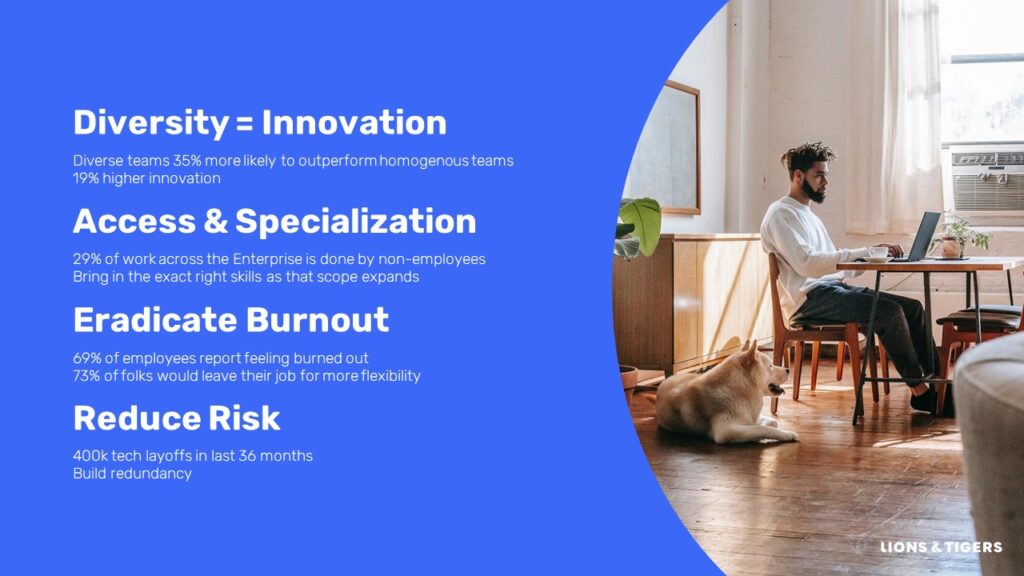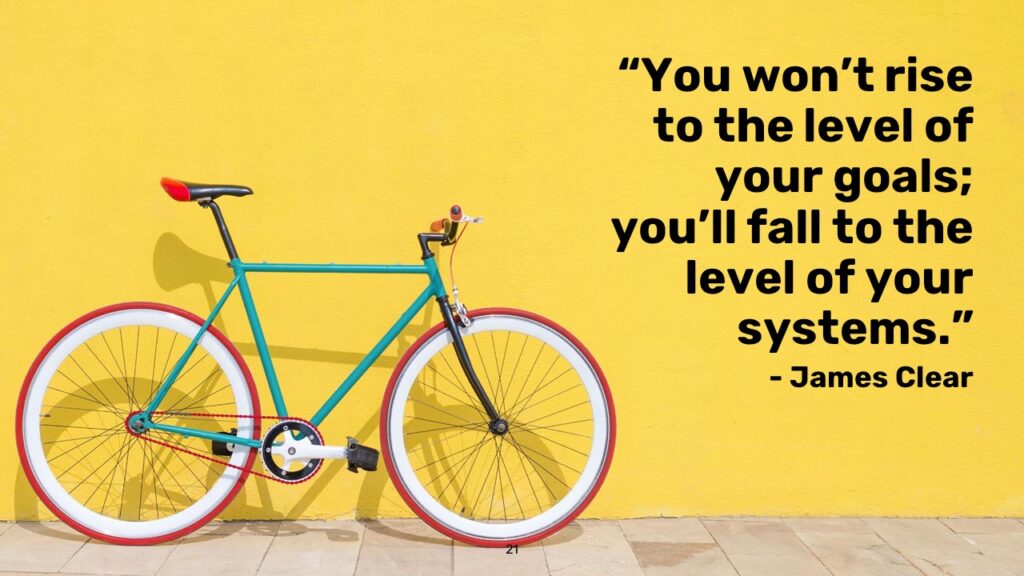Last month our CEO and founder, Brea Starmer held a 30-minute session on LinkedIn Live during which she presented a blueprint for creating high-performance teams. Drawing from our work at Lions & Tigers, she shared insights on how to transform your organization using blended teams and our Highest & Best Use framework.
The Future of Work: Independent & Blended Teams
By 2027, it’s predicted that 50% of the workforce will be engaged in independent work. This includes side hustles, gig work, consulting, and freelance opportunities. Leaders must strategize to embrace this trend. Currently, 60 million workers identify as independent, a figure expected to rise dramatically. Future of work thought leader, Paul Estes, notes that missing out on the gig worker revolution would be akin to missing the mobile or PC revolutions of past decades.
A blended workforce, which includes both employees and non-employees, already constitutes roughly 29% of work done today. This approach not only broadens access to talent but also fosters economic inclusivity by offering fractional work opportunities to those who might otherwise be excluded from full-time employment.
Benefits of a Blended Workforce
When we discuss the benefits of a blended workforce with leaders, several key advantages consistently emerge:
- Diversity and Innovation: Diverse teams, encompassing varied identities and experiences, drive greater innovation. Studies show that diverse teams are 35% more likely to outperform homogenous ones and see a 19% increase in innovation.
- Access to Specialized Skills: A blended workforce allows organizations to access specialized skills on a fractional basis, making it possible to bring in experts for specific tasks without committing to full-time hires.
- Burnout Reduction: With 69% of employees reporting burnout, and 70% of those considering leaving for more flexible work, a blended workforce can help distribute workloads more evenly, reducing burnout and attrition.
- Risk Reduction: Building redundancy into teams can mitigate the impact of economic fluctuations and large-scale layoffs. This approach helps maintain continuity and retain crucial institutional knowledge.

Lions & Tigers’ Approach: Highest & Best Use
At Lions & Tigers, we employ a system called Highest & Best Use to build high-performing teams. This concept, a term borrowed from real estate, involves maximizing the potential of your team members in alignment with your organizational goals. It’s about creating a system of leverage where everyone’s unique skills and motivations are fully utilized.
Implementing the Highest & Best Use Framework
The Highest & Best Use framework is built on 3M’s:
- Magnets: These are the attraction principles- the things that pull us together, the reasons we get up in the morning, the things that fire us up.
- Momentum: These are the resources and forces propelling us forward- the things that are working well and making our business go, our product market fit.
- Maximums: These are the boundaries we need to respect in order to continue our progress.

By aligning these three elements, we create a cohesive blueprint for organizational success. This alignment ensures that each team member’s unique capabilities are leveraged to meet the organization’s goals efficiently and sustainably.
STEP 1: The first step is to identify your organization’s Highest & Best Use by taking the 3 M’s framework and drawing up an ideal business plan. It’s agnostic of who you have and what you have, you look at your 3 M’s so you can design a business plan that honors the objectives that are being asked of you.

- Magnets: These are our business strategies- the things that get people excited to come to work every day, the things that we feel are the bets that we want to make.
- Momentum: These are the resources- human resources, tech, stakeholders, and allies.
- Maximums: This is pace- our collective pace that we can move at so that we can create sustainable work.

As a leader, when you’re starting to design this system, you can work through some prompts to start documenting the ideal organizations using the 3 MS:
- Magnets- Business Strategies: Document the way that your team is aligned. What is your vision? What is your business mission (including your bets and focus areas)? What is the thing that you do better than anybody else? You need to document that so that you understand what you’re shooting for.
- Momentum- Resources: Next document the things that are really working well. This could include budget, and P&L. What are the dollars that you have to put into this initiative? What are the human resources that you have dedicated to it? You might build out your stakeholder analysis here and the folks that are aligning to you so that you can propel your business forward within your enterprise.
- Maximum- Pace: Document what capacity you need to achieve these goals. Sometimes there’s a gap around budget or a gap around headcount. Where are you being blocked? What are the market conditions? What are headwinds that you’re up against and a forecast for how you need to show up?
When these things all come together, that is how you unlock an organizations’ Highest & Best Use.

Individual Highest & Best Use
STEP 2: We need to get everyone on board. The next step in this system is to integrate the team’s Highest & Best Use. To truly unlock a team’s potential, we need to consider each individual’s Highest & Best Use. This involves understanding their personal motivations, skills, and boundaries. By aligning these with the organization’s needs, we can create a supportive and productive environment.

Mapping Individual & Organizational Goals
Here’s how we integrate your team’s individual Highest & Best Use:
- Magnet- Motivation: Identify what excites each team member and how that aligns with the organization’s vision.
- Momentum- Skills: Leverage the unique skills of each individual to meet the organization’s momentum needs.
- Maximum- Boundaries: Respect individual boundaries to ensure sustainable work practices and prevent burnout.

The other thing that we think about for individuals is what are the systems that we’re building around them so that when they intersect with your business objectives, it’s in a way where we’re taking advantage of all of those outcomes at HBU. This looks like rhythm of business, culture, the way in which we enable individuals to show up demonstrate their impact. Those are the sort of practical notions that a manager has to think about when they’re inviting an individual into an organization that’s built for high performance.
We then map those with the organization’s Highest & Best Use. We look at whether we have the right people who are motivated every morning to get up and attack the business priorities that we have. Do we have the skills in house that we need to achieve the outcomes that we’re going after? Are the human resource needs matching what we have, and the pace that the organization is expecting us to move at? Do the individual boundaries we have match? Do we have gaps in any of these categories? And if so, how do we start to close those gaps?

This approach helps identify and close any gaps, allowing us to bring in specialized talent as needed, whether through freelancers, contractors, or consultants. It’s an opportunity for us to think about a blended workforce as a solution to those gaps, as opposed to the old playbook where we work people harder and longer and as a result see attrition.
Case Study: A Success Story
One of our clients, a large tech enterprise, faced the challenge of scaling their team after securing significant investment. But when you get an investment like that, your team now has to do, in this case, 20x the amount of work that they were doing in the year before. With only 11 full-time team members, they needed to triple in size while meeting their new targets.
This leader trusted our team to come in as what she called her “outsourced leadership team”, while we helped her design her organization. We pulled in an analytics expert who helped her do some business modeling to forecast what the business was going to look like five years from now. We worked our way backwards from the product build that needed to happen. We were able to figure out the skills that were needed across program management, go to market product build, and in this case, it was a skilling initiative. And then we brought in a whole army of project managers to help document the operating procedures and the kind of business infrastructure that was required for this team to go through that change management motion. This was in a period of about 90 days. And then we also wrote the job descriptions for the full-time team members that would then be hired and helped support that interviewing process while they hired on their full-time staff.
What’s been incredible is that through that process, they had no attrition of that core group of 11 that received the funding. And we still have a team of three or four folks that have supported that team over the last couple of years that have stayed on in a consulting capacity. This flexible approach shows the power of a blended workforce- how a flex team can come in, support an initiative, and then see it play out over time while preventing burnout and attrition.
Final Thoughts
James Clear, in his book Atomic Habits, says, “You don’t rise to the level of your goals; you fall to the level of your systems.” By leveraging the new models of work and creating inclusive systems, we can unlock incredible potential within our teams.

If you’re interested in building high-performance teams and need support, Lions & Tigers is here to help. We offer workshops, co-design blended teams, and provide access to top-notch fractional talent. Reach out to us here.
Check out our Highest & Best Use playbook for more insights.
Watch full webinar here








0 Comments